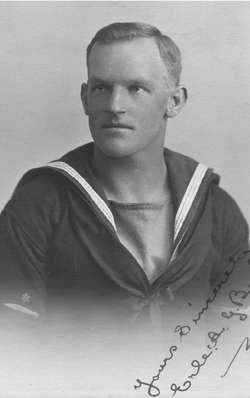- Author
- Swinden, Greg
- Subjects
- Biographies and personal histories, WWI operations
- Tags
-
- RAN Ships
- None noted.
- Publication
- March 2010 edition of the Naval Historical Review (all rights reserved)
Forgotten Hero of the RAN
Amongst the thousands of men and women who have served in the RAN there have been heroes and rogues, scholars and scoundrels. In a career spanning nearly 40 years and the two World Wars, Erle Boyd was definitely one of the heroes.
Erle Alwin Greglach Boyd was born in Bendigo, Victoria on 24 April 1892, the ninth child of Scottish born Hugh Boyd (a medical practitioner) and Bendigo-born Julia Elizabeth Boyd (nee Maddox). After growing up in a strict Presbyterian family and working as an apprentice fitter and turner he joined the Australasian Naval Forces (ANF) on 4 March 1911, aged 18. The ANF was a section of the Royal Navy which recruited young Australians and New Zealanders to man the ships of the RN Squadron based in Sydney.
After serving in the cruisers HM Ships Psyche (4 March 1911 – 21 June 1912) and Challenger (22 June – 31 October 1912) he was posted to HMS Victory (Portsmouth) for transfer to the newly created RAN. On 1 January 1913 Ordinary Seaman Boyd joined the RAN and a few weeks later he was part of the commissioning crew of the new cruiser HMAS Melbourne which had been built in England. He was promoted to Able Seaman in April 1913.

When World War I broke out in August 1914 he was serving in the destroyer HMAS Warrego and took part in the capture of German New Guinea in September of that year. Several men from Warrego, and the destroyer HMAS Yarra, were landed on 11 September 1914 to help with the capture of the German wireless station at Bita Paka and Boyd was later to claim that he was one of the men who landed, with cutlass in hand, to fight the Germans.
A few days later Warrego captured the small German vessel Nusa and in December steamed up the Sepik River, in company with HMAS Parramatta, searching for other German shipping and also to advise Germans living in the area of the capture of the colony. Warrego remained in New Guinea waters until she returned to Australia in February 1915. Based in Sydney, the destroyer then operated off the east coast of Australia, in company with her sister ships Parramatta and Yarra, for the next eight months.
Erle Boyd married Dorothy May Meeks with Presbyterian rites, at a private residence in Bourke Street, Sydney on 11 September 1915 and they had three children (two sons named Walter and Hugh and a daughter Dorothy, although it would appear that Walter was born in April 1913, before Erle and Dorothy were married). In October 1915 he was posted to the RAN College (located at Captains Point, Jervis Bay) as a member of the crew of the College training vessel HMAS Franklin. It was while serving at Jervis Bay that an incident occurred in which Boyd distinguished himself.
On Sunday 19 March 1916 a group of five sailors from the College, including Boyd, took a cutter on a sailing expedition to the small township of Huskisson about eight miles north of Captains Point. They spent the day with friends at Huskisson and towards dusk commenced the run back to the College. The weather began to change and the cutter’s crew were required to tack frequently as the wind changed. About five miles from Captains Point a sudden gust of wind capsized the boat and flung all five men into the water.
Four of the sailors managed to get onto the hull of the upturned cutter but the fifth was missing. Boyd, who was a very strong swimmer, repeatedly dived under the water until he located the man and dragged him to the side of the boat. The weather continued to deteriorate and night had fallen. The light of the lighthouse at Point Perpendicular and that of the Naval College provided the only illumination.
The men realised that with the poor weather and the increasing cold, any attempt to hang onto the boat overnight and await rescue in the morning was untenable. Boyd, as the strongest swimmer, made the decision to swim to the shore, which was about three miles away, and raise the alarm. He stripped off his clothing and commenced to swim for shore but was forced back to the upturned boat by severe cramps caused by the cold water. By this time one of the men left behind had succumbed to hypothermia and had drifted away from the boat. The others were too weak to rescue him and Boyd realised the situation was now desperate.




